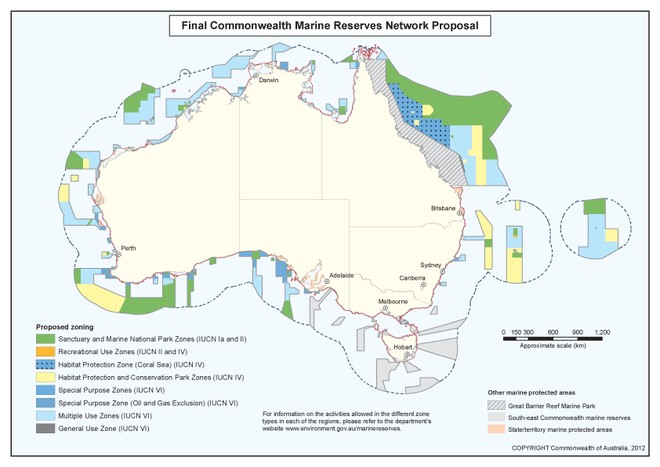Marine Parks announced - challenges for fishing and boating industries
by Jeni Bone on 14 Jun 2012

Marine Park Zones SW
The Australian government has unveiled the world's largest system of marine reserves with plans that put limits on oil and gas exploration in Western Australia, extend reef protection in the Coral Sea and possibly open the flood gates for compensation potentially worth hundreds of millions of dollars for the commercial fishing industry.
Environment Minister Tony Burke released the final map for the proposed Coral Sea marine park, as part of 44 new marine reserves to cover Australia’s waters.
'It's time for the world to turn a corner on the protection of our oceans,' Minister Bourke said.
'This is a massive step forward in ocean protection. We have decided to become the world leader in ocean protection. The jewel of the crown in the entire process goes to the Coral Sea.'
While more than a third of Australia's ocean will be protected under a Gillard Government plan to add 44 large-scale marine reserves to the national network, the plan falls short of demands by environmental groups to create the world's largest single marine park in the Coral Sea in which all commercial activity would be banned.
Mr Burke said the government's aim was to protect Australia's unique marine environment, 'while supporting coastal communities and marine industries around the country'.
'Over the coming months, the government will consult the fishing industry and fisheries management agencies on the design and implementation of a fisheries adjustment assistance package,' he said.
He warned it was too late to change the size of the reserves and their location.
'The question now is very straight forward: Do we go ahead with the most comprehensive marine park network in the world or do we not?' he said.
The new marine reserves take the overall size of the Commonwealth marine reserves network to 3.1 million square kilometres, and features:
* The Coral Sea Region - which covers an area of more than half the size of Queensland - supports critical nesting sites for the green turtle and is renowned for its diversity of big predatory fish and sharks
* The South-West Marine Region - which extends from the eastern end of Kangaroo Island in SA to Shark Bay in WA - is of global significance as a breeding and feeding ground for a number of protected marine species such as southern right whales, blue whales and the Australian Sea Lion
* The Temperate East Marine Region - which runs from the southern boundary of the Great Barrier Reef Marine Park to Bermagui in southern NSW - includes the waters surrounding Lord Howe and Norfolk Islands and is home to the critically endangered east coast population of grey nurse shark, the vulnerable white shark and has important offshore reef habitat at Elizabeth and Middleton Reefs and Lord Howe Island that support the threatened black cod
* The North-West Marine Region - which stretches from the WA-NT border through to Kalbarri, south of Shark Bay in WA - is home to the whale shark which is the world's largest fish and provides protection to the world's largest population of humpback whales that migrate annually from Antarctica to give birth in the water off the Kimberely
The Marine National Park Zones (green on the national map) provide the highest level of protection, banning extractive activities including fishing and petroleum.
Passage of vessels is still allowed in those zones, as is tourism and some recreational activities, such as diving.
The Habitat Protection Zones and Conservation Park Zones (yellow on the map) protect habitats such a coral reefs.
Some low impact extractive activities - including some forms of commercial fishing - are allowed in those areas, while recreational fishing and tourism are allowed.
The Multiple Use and Special Purpose Zones (light blue and dark blue on the map) allow for a greater range of activities, both recreational and commercial. Some activities, for example bottom trawl and gillnet fishing, are excluded.
It is expected that the final marine reserves will be declared before the end of the 2012.
If you want to link to this article then please use this URL: www.sail-world.com/98440